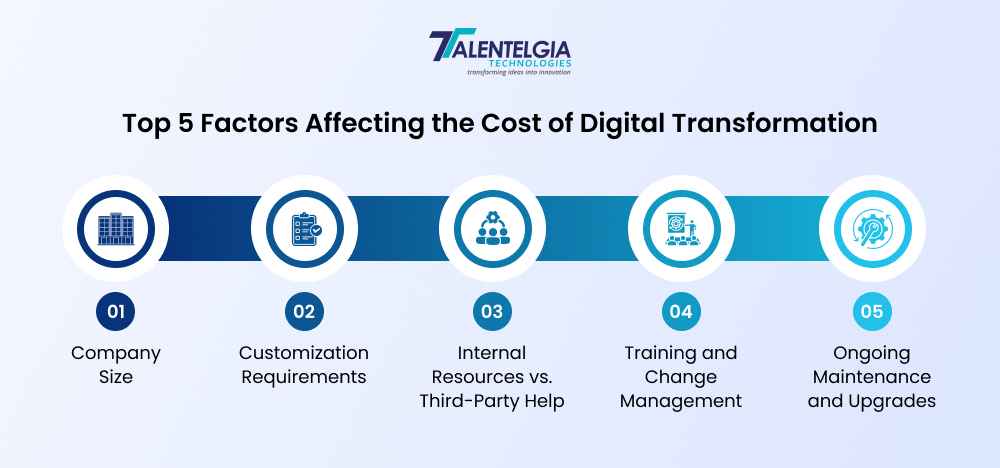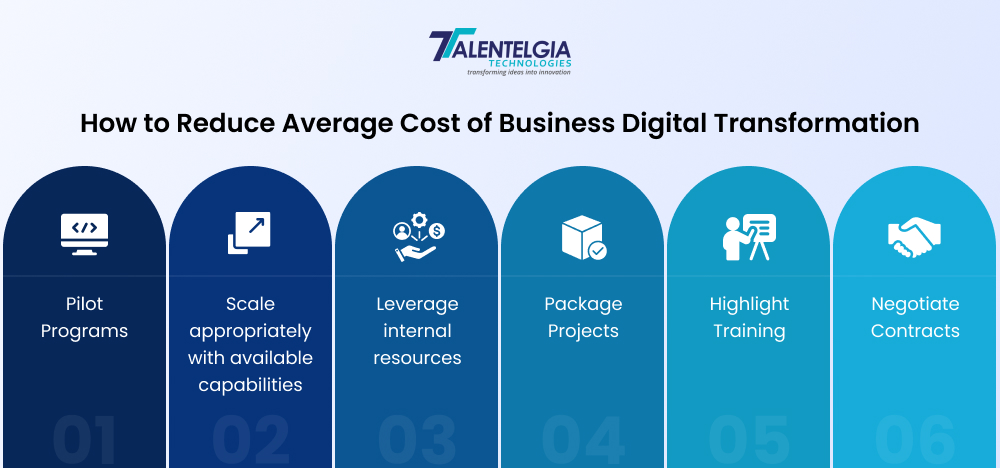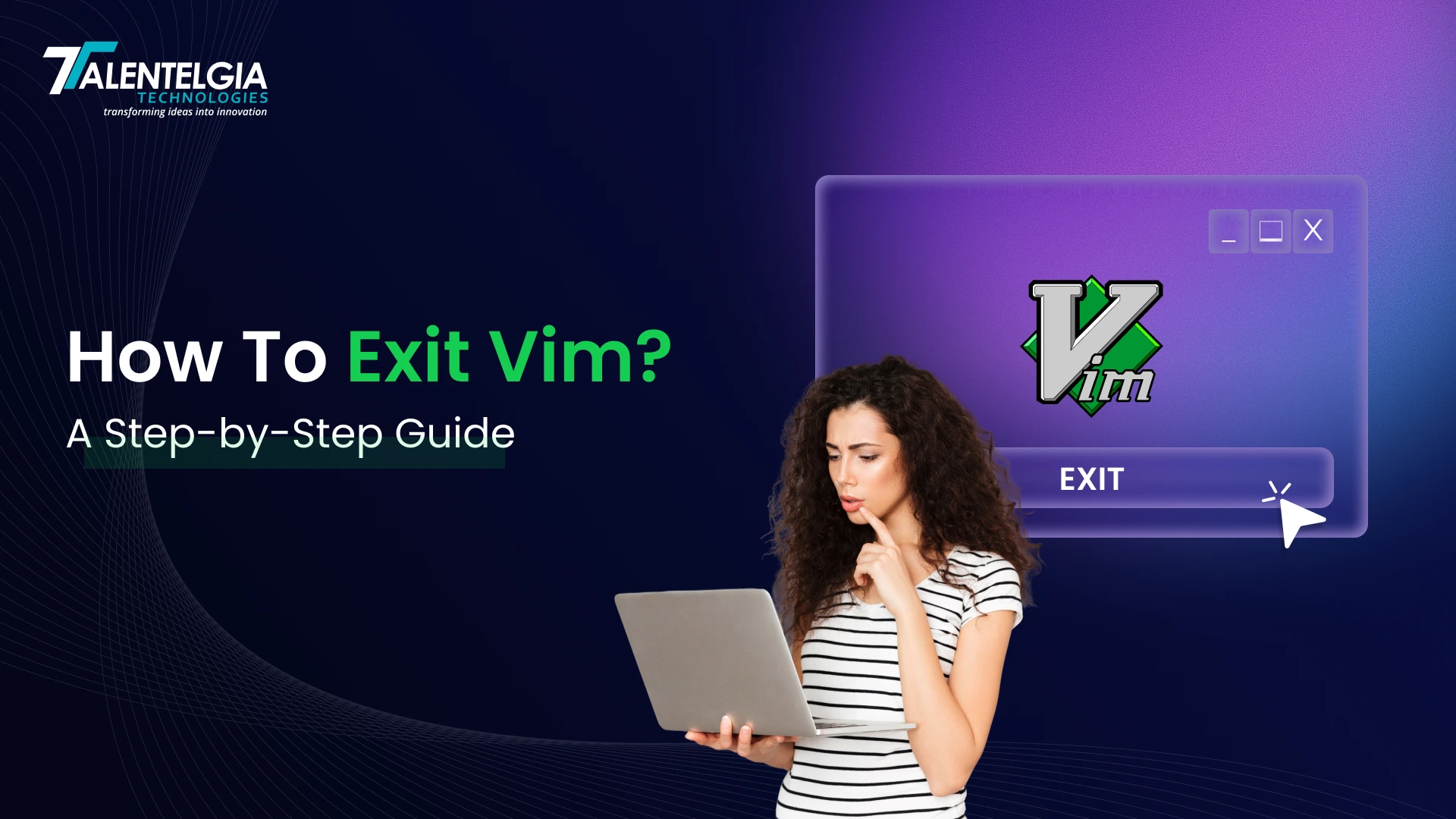Spending on digital transformation is forecasted to hit $4 trillion by 2027 (IDC)
Digital transformation is happening in every industry. Companies are integrating digital technologies to streamline operations and improve the customer experience. However, for business leaders considering this shift, one of the biggest questions is: ‘What is the average cost of digital transformation?’
So, this blog will help you understand the cost of digital transformation, its contributing factors, and how to plan its flawless implementation..
What is Digital Transformation?
Digital transformation is the process of adapting digital tools and technologies to transform and digitize business processes.
Digital transformation can also involve automating business processes integrating advanced analytics or deploying cloud services for business processes. This ensures enhanced services for end users by leveraging modern technologies. Moreover, it also includes migrating from traditional to cloud-based systems.
Average Cost of Digital Transformation
According to McKinsey 89% of large companies globally have a digital and AI transformation journey underway.
The cost of digital transformation is diverse and can vary for each business. For small and medium businesses, moderate projects might cost between $50,000 and $500,000. While some big companies may even reserve up to 3% to 5% of their annual revenue for digital transformation efforts!
The cost of digital transformation is flexible for every business. Here’s why:
- Different business goals: The scope of the transformation project varies depending on individual goals. Corporate goals can be as simple as getting a newer software tool or could be all-inclusive, requiring a complete business transformation.
- Size and scale: Larger companies have more employees, greater volumes of data, and need more investment in IT infrastructure. This leads to increased complexity and adds to the cost of digital transformation.
- Type of technology: Some technologies, like AI or ML, are costlier than the general standard cloud solutions or digital marketing tools.
Let’s expand this further by looking at the major factors influencing the cost.
Major Factors Affecting the Cost of Digital Transformation

Gartner Forecasts Worldwide IT Spending to Grow 7.5% in 2024
Digital transformation is a great facilitator for innovation and growth for any business. However, it can sometimes be costly. The key points below explain the factors affecting the end-to-end cost of digital transformation and will simplify the entire process for you. Read below to find out:
Company Size
The cost of digital transformation depends on the size of the company. For a smaller company with 50 employees, the cost will be less as there are fewer processes to automate. The complexity of digital transformation increases with the increase in company size. A big organization with 5,000 employees will require complex solutions and more investment.
digital transformation journey? Get in touch with our team and accelerate
your business growth. Contact us today
for a business analysis.

Additionally, big companies require extensive data migration strategies, improvements in IT infrastructure, and integrations with existing systems. This adds to the cost.
Moreover, each department in these big companies requires digital solutions. These customized solutions require more expenses not only for their development but also for maintenance.
Customization Requirements
There are several reasons why open-source solutions are popular today. They are widely available and much cheaper compared to custom software. However, they may not cater to your core business needs.
However, custom-built solutions cater specifically to a company’s unique operations, thereby making them agile, efficient, and scalable in the long run.
This personalization boosts productivity, reduces errors, and simplifies processes to increase the project’s return on investment. Also, custom solutions are usually quite compatible with other tools and systems that the business is already using. This reduces the number of disruptions and gives you a competitive edge.
However, the development and deployment of custom software add to the cost of digital transformation. It requires business knowledge, collaboration between stakeholders, and a testing process that needs more time and investment.
Internal Resources vs. Third-Party Help
Leveraging internal resources is less expensive for digital transformation if a company has an effective IT team. However, all changes usually require expertise in technologies like AI, blockchain, or machine learning. The implementation of this advanced technology requires technology partners such as an IT consulting company, as they possess related experience and knowledge.
A strategic approach to balancing the cost of digital transformation is using in-house resources to do the simpler work while engaging external resources for complex work. This hybrid approach provides flexibility and control over cost but must be planned carefully so the internal and external teams may collaborate.
Usually, it is better to begin with the internal team. Working with third-party resources often results in faster implementation but is more expensive. However, they add more expertise to your team, ensuring quality end-to-end solutions.
Training and Change Management
Training can either be through workshops, online courses, or hands-on sessions, and the cost can range between $1,000 to $5,000 per person. Change management is critical in digital transformations at a bigger level because it guides employees during this change, addresses concerns, and builds a culture receptive to technological shifts.
Effective change management is critical; otherwise, even the most advanced AI business solutions may fail if employees resist using them. It involves structured communication, feedback loops, and continuous support to ensure the transition is smooth and that employees are supported through this process. Investing in full-scale training and change management saves time and also protects them from bottlenecks later on.
Ongoing Maintenance and Upgrades
Digital transformation is not a one-time expense; it requires constant investment to keep systems up-to-date and fully functional. Software licenses may need to be renewed and sometimes upgraded for compatibility and security purposes.
Custom solutions also need scalability as business needs change, and may also require AI integration with other products or services.
Maintenance costs are estimated to be between 15-20% of the original cost. This also covers expenses related to software updates, security patches, and support services. For instance, it would require around $75,000 to $100,000 for annual maintenance on a $500,000 project.
Overlooking maintenance creates performance issues along with security vulnerabilities. This can reduce the ROI earned on investment in digital transformation.
Examples of Digital Transformation Costs by Industry
The forecasts by IDC indicate that the digital transformation market will achieve a five-year CAGR of 16.2% from 2022 to 2027.
Every industry has challenges that vary in terms of cost. The cost of digital transformation differs widely among businesses. This section describes how the cost of digital transformation can vary for each industry.
- Retail: Retail companies focus primarily on customer experience and usually spend $100,000 to $1 million on digital transformation. Examples include personalized marketing and mobile payment solutions.
- Manufacturing: For manufacturing companies, it usually involves IoT sensors, automation, and predictive maintenance. For such a change, the costs can range between $500,000 and $5 million, based on scope.
- Healthcare: For healthcare provider companies, it involves electronic health records, telemedicine, and patient data security. The costs start at around $250,000 and extend well into more than $2 million.
Tips to Reduce the Cost of Digital Transformation

Most digital businesses worry about the hefty cost of digital transformation when they automate their processes. However, this is achievable by setting a budget and planning an efficient execution. This section offers actionable advice that enables you to save money and become and improve business growth!
- Pilot Programs: Try pilot programs to test and measure impact before full-scale transformation. For example, don’t try to transform all customer service processes in one go. Start with an AI-driven chatbot for simple inquiries first. Expand to others if that works well.
- Scale appropriately with available capabilities: Cloud computing and subscription-based models allow companies to pay only for what they need today and scale up later.
- Leverage internal resources: Utilize the maximum skills available within your team. If your IT staff is already conversant with cloud services, leverage their expertise. This could lead to straightforward implementations without looking outward for everything.
- Package Projects: Many technologies offer discounts if you avail of more than one service. For example, most cloud providers offer great discounts if you use their site for storing data, analytics, and machine learning.
- Highlight Training: The right investment in proper training can limit the likelihood of error and increase future productivity. Good practice of change management can avoid re-implementation costs or, worse, user resistance later on.
- Negotiate Contracts: Digital transformation projects involve long-term contracts with providers. So, negotiate terms, ask for trials, or get package deals. They are often flexible, especially for long-term partnerships.
Conclusion
Digital transformation can sometimes be costly, but it does not have to be intimidating. Knowing what factors impact the costs and in which way to set up the budgets can help you handle the costs of digital transformation wisely.
So, follow a clear plan, and ensure that every need is addressed in planned phases. Moreover, as technology continues to evolve and develop the cost of digital transformation may only drop lower.
Businesses of all sizes can access modern cloud services and automation solutions. A successful digital transformation can ultimately prepare a business for better productivity, growth, and sustainability in the digital-first world.


 Healthcare App Development Services
Healthcare App Development Services
 Real Estate Web Development Services
Real Estate Web Development Services
 E-Commerce App Development Services
E-Commerce App Development Services E-Commerce Web Development Services
E-Commerce Web Development Services Blockchain E-commerce Development Company
Blockchain E-commerce Development Company
 Fintech App Development Services
Fintech App Development Services Fintech Web Development
Fintech Web Development Blockchain Fintech Development Company
Blockchain Fintech Development Company
 E-Learning App Development Services
E-Learning App Development Services
 Restaurant App Development Company
Restaurant App Development Company
 Mobile Game Development Company
Mobile Game Development Company
 Travel App Development Company
Travel App Development Company
 Automotive Web Design
Automotive Web Design
 AI Traffic Management System
AI Traffic Management System
 AI Inventory Management Software
AI Inventory Management Software
 AI Software Development
AI Software Development  AI Development Company
AI Development Company  AI App Development Services
AI App Development Services  ChatGPT integration services
ChatGPT integration services  AI Integration Services
AI Integration Services  Generative AI Development Services
Generative AI Development Services  Natural Language Processing Company
Natural Language Processing Company Machine Learning Development
Machine Learning Development  Machine learning consulting services
Machine learning consulting services  Blockchain Development
Blockchain Development  Blockchain Software Development
Blockchain Software Development  Smart Contract Development Company
Smart Contract Development Company  NFT Marketplace Development Services
NFT Marketplace Development Services  Asset Tokenization Company
Asset Tokenization Company DeFi Wallet Development Company
DeFi Wallet Development Company Mobile App Development
Mobile App Development  IOS App Development
IOS App Development  Android App Development
Android App Development  Cross-Platform App Development
Cross-Platform App Development  Augmented Reality (AR) App Development
Augmented Reality (AR) App Development  Virtual Reality (VR) App Development
Virtual Reality (VR) App Development  Web App Development
Web App Development  SaaS App Development
SaaS App Development Flutter
Flutter  React Native
React Native  Swift (IOS)
Swift (IOS)  Kotlin (Android)
Kotlin (Android)  Mean Stack Development
Mean Stack Development  AngularJS Development
AngularJS Development  MongoDB Development
MongoDB Development  Nodejs Development
Nodejs Development  Database Development
Database Development Ruby on Rails Development
Ruby on Rails Development Expressjs Development
Expressjs Development  Full Stack Development
Full Stack Development  Web Development Services
Web Development Services  Laravel Development
Laravel Development  LAMP Development
LAMP Development  Custom PHP Development
Custom PHP Development  .Net Development
.Net Development  User Experience Design Services
User Experience Design Services  User Interface Design Services
User Interface Design Services  Automated Testing
Automated Testing  Manual Testing
Manual Testing  Digital Marketing Services
Digital Marketing Services 
 Ride-Sharing And Taxi Services
Ride-Sharing And Taxi Services Food Delivery Services
Food Delivery Services Grocery Delivery Services
Grocery Delivery Services Transportation And Logistics
Transportation And Logistics Car Wash App
Car Wash App Home Services App
Home Services App ERP Development Services
ERP Development Services CMS Development Services
CMS Development Services LMS Development
LMS Development CRM Development
CRM Development DevOps Development Services
DevOps Development Services AI Business Solutions
AI Business Solutions AI Cloud Solutions
AI Cloud Solutions AI Chatbot Development
AI Chatbot Development API Development
API Development Blockchain Product Development
Blockchain Product Development Cryptocurrency Wallet Development
Cryptocurrency Wallet Development About Talentelgia
About Talentelgia  Our Team
Our Team  Our Culture
Our Culture 
 Healthcare App Development Services
Healthcare App Development Services Real Estate Web Development Services
Real Estate Web Development Services E-Commerce App Development Services
E-Commerce App Development Services E-Commerce Web Development Services
E-Commerce Web Development Services Blockchain E-commerce
Development Company
Blockchain E-commerce
Development Company Fintech App Development Services
Fintech App Development Services Finance Web Development
Finance Web Development Blockchain Fintech
Development Company
Blockchain Fintech
Development Company E-Learning App Development Services
E-Learning App Development Services Restaurant App Development Company
Restaurant App Development Company Mobile Game Development Company
Mobile Game Development Company Travel App Development Company
Travel App Development Company Automotive Web Design
Automotive Web Design AI Traffic Management System
AI Traffic Management System AI Inventory Management Software
AI Inventory Management Software AI Software Development
AI Software Development AI Development Company
AI Development Company ChatGPT integration services
ChatGPT integration services AI Integration Services
AI Integration Services Machine Learning Development
Machine Learning Development Machine learning consulting services
Machine learning consulting services Blockchain Development
Blockchain Development Blockchain Software Development
Blockchain Software Development Smart contract development company
Smart contract development company NFT marketplace development services
NFT marketplace development services IOS App Development
IOS App Development Android App Development
Android App Development Cross-Platform App Development
Cross-Platform App Development Augmented Reality (AR) App
Development
Augmented Reality (AR) App
Development Virtual Reality (VR) App Development
Virtual Reality (VR) App Development Web App Development
Web App Development Flutter
Flutter React
Native
React
Native Swift
(IOS)
Swift
(IOS) Kotlin (Android)
Kotlin (Android) MEAN Stack Development
MEAN Stack Development AngularJS Development
AngularJS Development MongoDB Development
MongoDB Development Nodejs Development
Nodejs Development Database development services
Database development services Ruby on Rails Development services
Ruby on Rails Development services Expressjs Development
Expressjs Development Full Stack Development
Full Stack Development Web Development Services
Web Development Services Laravel Development
Laravel Development LAMP
Development
LAMP
Development Custom PHP Development
Custom PHP Development User Experience Design Services
User Experience Design Services User Interface Design Services
User Interface Design Services Automated Testing
Automated Testing Manual
Testing
Manual
Testing About Talentelgia
About Talentelgia Our Team
Our Team Our Culture
Our Culture

















 Write us on:
Write us on:  Business queries:
Business queries:  HR:
HR: 




